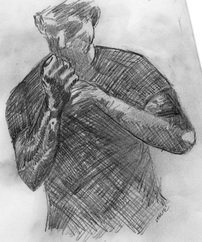Lesson 1: Don't let a guy fold you forward like a pretzel. Once you are familiar with what a full nelson feels like in its approach, far better to react by pulling your elbows in close to your body and he will not be able to set the hold. Meanwhile a few head butts and heel clips to the groin should offer deterrence.
If you do get folded forward, you are screwed so this technique teaches that if you are going down don't fight it but at least go to the ground on your terms as much as possible. We accentuate the circle of the fold and with our right arm pinning (I hug that my right arm tight to my own body trapping his right arm) we roll and become the inside of the circle while our opponent becomes our crash pad. Everything after that is just to mop things up and go home safely.
Thus the principle of nonresistance is applied, demonstrated, and drilled in this technique. To go with their momentum, to not fight against their energy but to add to their directional momentum and thus take ownership over their energy by adding to it! It would be like somebody gave you a check for $250 that would not clear because their account was $5 short. Deposit $6 in their account and now that $250 is yours. Better to have walked away with $244 than a just a bad check.
Controlling Animal Theory: The full nelson is a snake attack (all grabs are) the defense is a crane action (folding our arm into the crane wing for the initial counter throw and the elbow, hammerfist, elbow action once on the ground is more of our wing folding, unfurling, and refolding.
Methods of Drill:
1. Definitely practice different ways to stop your opponent before having to resort to being folded and flipping down to the ground with him.
2. Practice a stand up version where you use a spin instead of a flip to redirect their folding energy and thus drive them into a wall, a nearby opponent, the bank atm machine, etc.
3. Lay a bag (kicking shield, heavy bag, few extra layers of mats) on the ground and practice generating striking power and follow through from this prone position. Leveraging is a little different when horizontal and not vertical!
4. Take the principle of non-resistance and freestyle drill being pushed, pulled, etc. and how you can move their energy and by adding to their momentum and vary the directional vectors of their force slightly you can take control over their position.
5. The "elbow, hammerfist, obscure elbow" combo can be applied in a variety of different contexts in both stand up and ground points of reference. Drill a variety of attacks and see when you might be able to make practical use of this combination.
Safety note: If the attacker (dummy) is considerably smaller than the one applying the technique than the attacker (dummy) will get crushed! Don't do it. Besides, how often do little guys try to put huge guys in a full nelson?
What's in a name? Their arms are folded in our arms which are like wings that are entangled. Just like two birds whose wings get all tangled up we too end up spiraling down to the ground (but with them on the bottom as our crash pad.)

 RSS Feed
RSS Feed